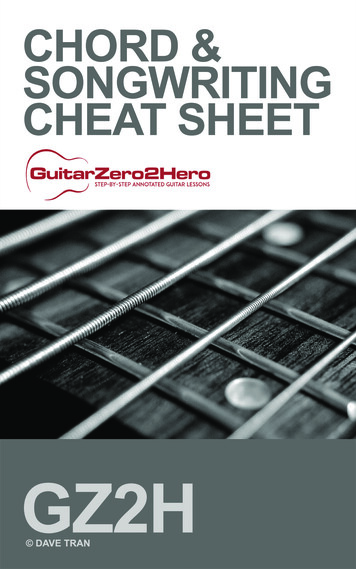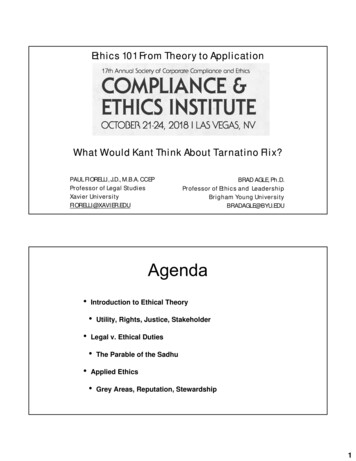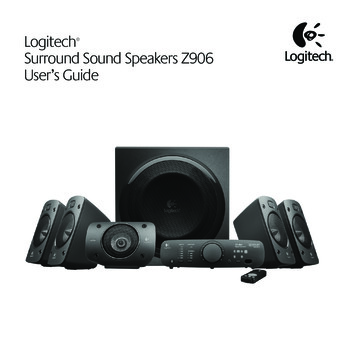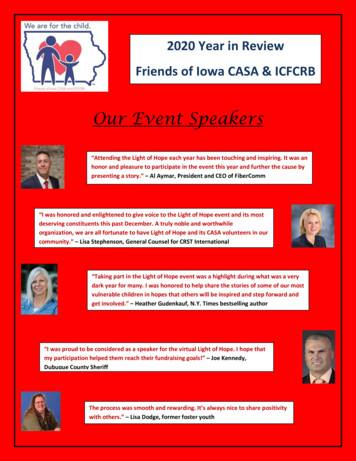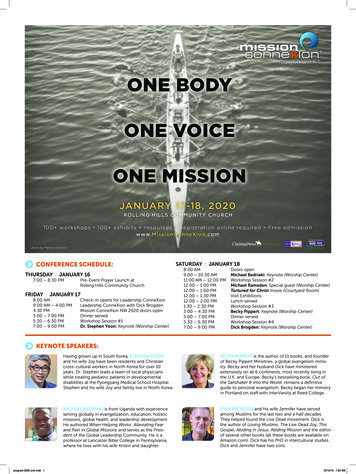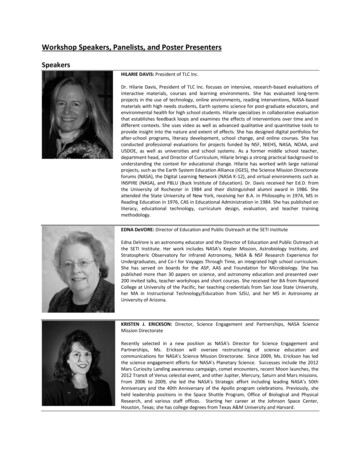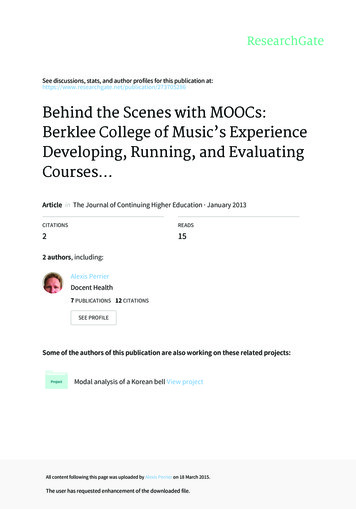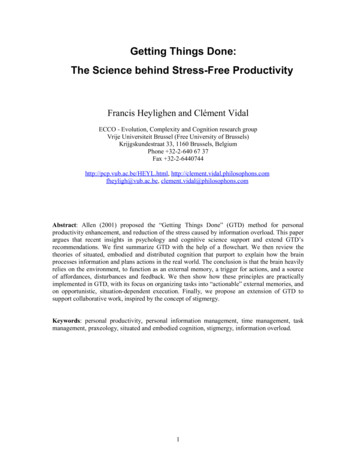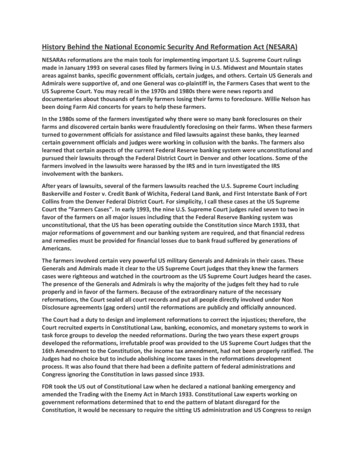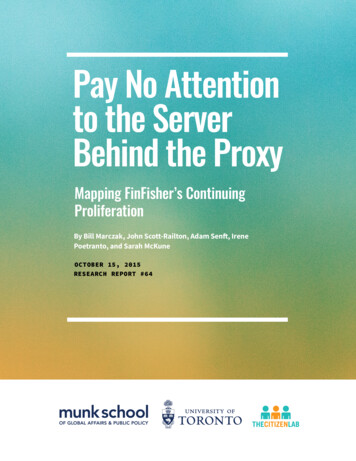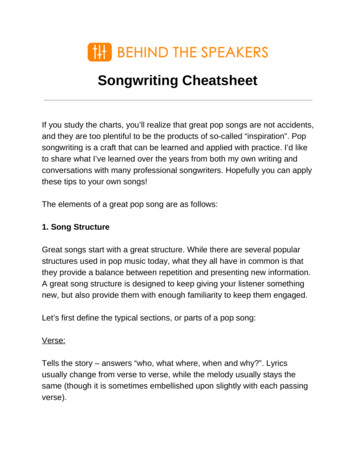
Transcription
Songwriting CheatsheetIf you study the charts, you’ll realize that great pop songs are not accidents,and they are too plentiful to be the products of so-called “inspiration”. Popsongwriting is a craft that can be learned and applied with practice. I’d liketo share what I’ve learned over the years from both my own writing andconversations with many professional songwriters. Hopefully you can applythese tips to your own songs!The elements of a great pop song are as follows:1. Song StructureGreat songs start with a great structure. While there are several popularstructures used in pop music today, what they all have in common is thatthey provide a balance between repetition and presenting new information.A great song structure is designed to keep giving your listener somethingnew, but also provide them with enough familiarity to keep them engaged.Let’s first define the typical sections, or parts of a pop song:Verse:Tells the story – answers “who, what where, when and why?”. Lyricsusually change from verse to verse, while the melody usually stays thesame (though it is sometimes embellished upon slightly with each passingverse).
Pre-chorus (or “the climb”):Functions to build energy and lead the listener into the chorus.Chorus:Sums up the message of the song – answers the question “so what?”.Contains the song’s “hook”. Lyrics and melody usually stay the same ineach chorus.Bridge:Provides lyrical and melodic contrast – usually by offering a different pointof view or perspective (something we haven’t heard before). Also providesa reason for leading the listener back to the final chorus.This brings us to the most common song structure used today:Verse -- Chorus -- Verse -- Chorus -- Bridge -- ChorusIt’s easy to see why this structure is the most common. It provides a perfectbalance between new information (the verses) and the familiarity of thechorus. And just when things might get a bit monotonous, the addition of abridge provides the contrast needed to mix things up. But we still end withthe familiarity of the chorus. Brilliant. If you’re new to songwriting andhaven’t tried writing to a specific structure, try it out!2. MelodyIn pop music, melody is everything. Writing a good melody isn’t difficult, buthere are a few things to keep in mind:
Keep it simple:The simpler your melody is, the easier it is to remember. If your melody istoo complicated, it will alienate your listeners. I often ask songwriters thequestion – could a preschooler sing this thing? If not, make it simpler. Hereare some tips to help simplify your melodies:Use stepwise motion:Most pop melodies are comprised almost entirely of stepwise motion(meaning the space between each note is primarily a whole step or less).Most melodies rarely leap more than a major third. When writing a melody,try to limit yourself to mostly stepwise motion - this will make the melodyeasier to sing along to (and easier to remember).Limit range:The range (musical distance between the lowest and highest note) of atypical pop song’s melody is just over an octave. Try to limit the range ofyour song’s melody - this will make it easier to sing along to (and alsoeasier for the artist to sing, as most pop singers have a limited register inwhich they sound their best).Tessitura:This is perhaps the most important parameter you can manipulate withregards to your melody. Tessitura refers to the highness or lowness of amelody. Writing a melody that is higher in a singer’s range will cause themto sing with more INTENSITY, vocal strain, and energy - while a lowermelody will sound more reserved.The trick to manipulating tessitura comes when you pair it with songstructure. A great melody mirrors the arc and energy of a song – often by
being lower in tessitura in the verses, rising slightly (perhaps by a third orfifth) during the pre-chorus, and then hitting the top of its range in thechorus. It’s no surprise that most melodies reach their highest pitch in thechorus – it’s where the song needs the most energy! By manipulating thetessitura of your melody, you can literally “add” emotion where it is neededthe most.Note stability:Without getting into music theory too heavily, it’s important to know thatcertain notes in a given key will feel more stable than others. What I meanis that certain notes give the listener a sense of resolution, while certainnotes make the listener sit on edge – thinking that there is more to come.The tonic (the “1” of a key – aka the note “A” in A major) and the dominant(the “5” of a key – aka the note E in A major) are more stable than anyother notes. Use this to your advantage when writing your melody – try tosave the tonic for the chorus if you can. Chorus melodies often end with thetonic as well. Why? Because the tonic provides the strongest sense ofresolution and completion – as should the end of your chorus!Rhythm:The rhythm of your melody can serve to provide additional contrastbetween various parts of your song. If your verse melody includes lots ofshort choppy phrases, try constructing a melody for your chorus that has afew long, connected phrases. The same goes for where your phrasesbegin. If your verse phrases begin primarily on offbeats, try constructing achorus melody where each phrase begins on the downbeat. The downbeatof “1” is the strongest and most “grounded” place to begin a phrase – if youthis place for your chorus, it will feel more “grounded” and stronger thananywhere else in your song (which is exactly what you want!).
3. Harmonic UnderpinningLet’s talk about the chords that sit under your melody and the rhythm atwhich they change. Choosing the right chords and the rate at which theychange can help strengthen your melody and propel your song.Chord stability:Remember when I mentioned that certain notes in a key sound more stablethan others? The same goes for chords. Let’s say I’m writing a song in thekey of C. The chord built off the tonic (the I chord, or C major) is going tofeel the most stable – so it would be wise to save this for the chorus. The Vchord (G major in the key of C) wants to resolve to the I chord (called acadence), so I might stick this chord at the end of the pre-chorus (so that itleads the listener right into the beginning of the chorus, where I’ve stuck theI chord). Chances are you’re doing many of things naturally already, butbecoming aware of why you’re making these choices will allow you tomanipulate them when necessary.Picking the right chords can serve to strengthen your melody by supportingmoments of tension, and providing release when necessary. If each sectionof your song starts on the same chord, try switching things up a bit. If youhaven’t already, try experimenting with different chords over the samemelody!Harmonic acceleration/deceleration:What we’re talking about here is literally the rate at which the chordschange. Chords that change at a faster rate have more energy incomparison to chords that change at a slower rate. Using this knowledge,we can accelerate the rate at which the chords change during parts thatneed more energy (hint: the chorus), and decelerate during times that don’t
(the verses).A perfect example is the song “Grenade”, by Bruno Mars. The verseprogression shifts between Dm and Am at 2 bars intervals. During the lasttwo bars of the verse, the chords accelerate - they switch every bar. Thechorus is based upon the progression [Dm, Bb, F, C] – but the chordsshift wait could it be? EVERY 2 beats! The chords are moving fasterthan they are in the verse - we’ve harmonically accelerated! And what’s theresult? The chorus feels like it’s moving faster, and with more energy.It’s no surprise that most pop songs harmonically accelerate during thechorus, as doing so adds energy and INTENSITY to the part of the songthat needs it the most. Bridges often harmonically decelerate in comparisonto the chorus (to provide contrast, as they are usually sandwiched betweentwo choruses).4. LyricsGood lyrics are an important part of any pop song – and good lyric writingis easier than it seems. Here are some tips:Can you sum it up?You should be able to sum up the entire message of your song in one shortphrase. Try it with any pop song on the charts right now, and then try it withyour own music. For example, “Someone Like You” by Adele could besummed up with this phrase: “You left me, but I still love you”. If you can’tsum up your song with one simple phrase, you’re trying to incorporate toomany ideas, or your idea isn’t clear enough. Keep it simple.Instead of abstract lyrics, paint a picture with sensory details.Great lyrics paint a picture for the listener by providing a wealth of sensorydetail that describes a story (tell us the who, what, where, when, and why).
Your lyrics should be simple and unfold like a story – you’ll alienate yourlisteners if your lyrics are too abstract.Make every line count:A song is too short for filler – thus, every line in your song’s lyrics shouldserve a function (develop the story, drive your main idea, provide contrast,etc ). Take out phrases that are repetitive, and words like “just” and“really”.Title (and title placement)When choosing a song title, pick something original and unique – notsomething that’s been overused a thousand times. Take a look at the songtitles of this week’s top 10 country hits for some great examples:1. Keep Me in Mind2. Let It Rain3. Drink In My Hand4. Tattoos On This Town5. Easy6. I Don’t Want This Night To End7. You8. All Your Life9. We Owned The Night10. RealityWith the exception of #7 (and maybe #5), every title on that list makes mewant to listen to the song.The titles of most pop songs almost always appear in their lyrics – usuallyat the beginning or end of their choruses. The title is often the song’s“hook” – which is usually the first or last line in the chorus. Listeners expect
to hear the song’s title in these places – if your song’s title isn’t clearlyevident after listening to it, how will they find it and buy it?More Resources:Here are two great books I highly recommend for anyone looking to divedeeper into understanding the craft of songwriting: John Braheny - The Craft and Business of Songwriting Sheila Davis – The Craft of Lyric WritingFor more music-making tips and tricks, visit BehindTheSpeakers.com .
Mix By Design is an online training course that will teach youhow to mix like a pro. You’ll discover a simple, step-by-stepsystem you can use to break through overwhelm, sink intothe creative flow, and make your best mixes yet.Ready to get on the path to pro mixes?Click Here To Learn More About Mix By Design
Songwriting Cheatsheet If you study the charts, you’ll realize that great pop songs are not accidents, and they are too plentiful to be the products of so-called “inspiration”. Pop songwriting is a craft that can be learned and applied with practice. I’d like to share what I’ve
